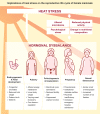Climate change and pregnancy complications: From hormones to the immune response
- PMID: 37091849
- PMCID: PMC10113645
- DOI: 10.3389/fendo.2023.1149284
Climate change and pregnancy complications: From hormones to the immune response
Abstract
Pregnant women are highly vulnerable to adverse environments. Accumulating evidence highlights that increasing temperatures associated with the ongoing climate change pose a threat to successful reproduction. Heat stress caused by an increased ambient temperature can result in adverse pregnancy outcomes, e.g., preterm birth, stillbirth and low fetal weight. The pathomechanisms through which heat stress interferes with pregnancy maintenance still remain vague, but emerging evidence underscores that the endocrine system is severely affected. It is well known that the endocrine system pivotally contributes to the physiological progression of pregnancy. We review - sometimes speculate - how heat stress can offset hormonal dysregulations and subsequently derail other systems which interact with hormones, such as the immune response. This may account for the heat-stress related threat to successful pregnancy progression, fetal development and long-term children's health.
Keywords: climate change; endocrine system; fetal development; heat stress; hormones; immune system; pregnancy; preterm birth.
Copyright © 2023 Yüzen, Graf, Diemert and Arck.
Conflict of interest statement
The authors declare that the research was conducted in the absence of any commercial or financial relationships that could be construed as a potential conflict of interest.
Figures




References
-
- Gauer R, Meyers BK. Heat-related illnesses. Am Fam Physician (2019) 99(8):482–9. - PubMed
Publication types
MeSH terms
Substances
LinkOut - more resources
Full Text Sources

